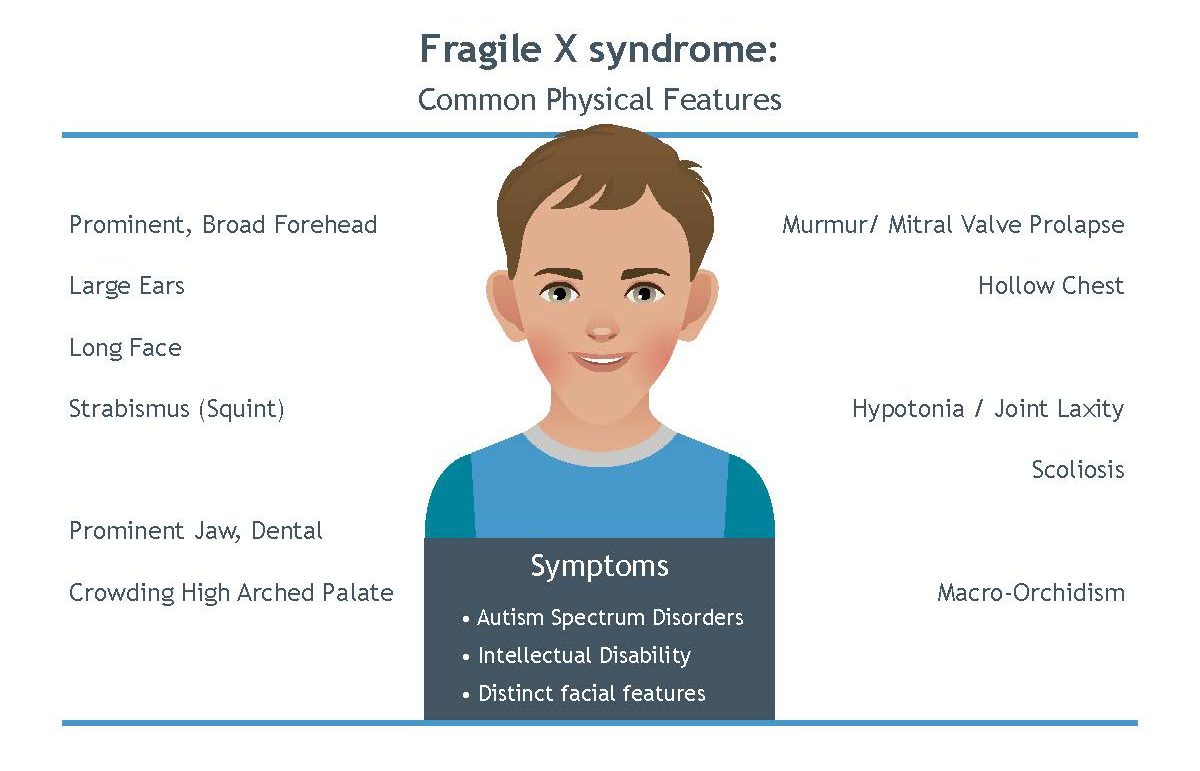What Is Fragile X Syndrome (FXS)?
Fragile X syndrome, also known as FXS, is a genetic condition that is caused by a full mutation of the FMR1 gene found on the X chromosome. Parents of children with FXS have described them as having “a great memory, a love to help others, and a great sense of humor” (National Fragile X Foundation, 2020). According to FRAXA Research Foundation (2020), FXS is characterized by intellectual disability, distinct physical characteristics, and behavioral challenges. There are also some common co-morbid disorders associated with FXS such as attention deficit disorder (ADD), autism, and hyperactivity.


Physical Features of FXS
(Asuragen, 2020)
Behavioral Features of FXS
Individuals with FXS are often described as shy or nervous, but once you give them time to warm up to you they tell stories in a fast, repetitive manner and usually hyper-focus on a topic that they are very interested in. The Children’s Hospital of Pittsburgh states that “Children with Fragile X Syndrome are often friendly, social, active children who are quick to learn by watching others” they also have strong visual problem-solving abilities aren are very verbal and outgoing.While someone with FXS  may also struggle with aggressive behavior and anxiety at times, this aggression is often misunderstood and results from a communication breakdown (O’Connor, 2018). It is important to understand how someone with FXS communicates in order to understand their behavior.
may also struggle with aggressive behavior and anxiety at times, this aggression is often misunderstood and results from a communication breakdown (O’Connor, 2018). It is important to understand how someone with FXS communicates in order to understand their behavior.
Picture Source (CDC, 2020)
Prevalence of FXS

(Image courtesy of FRAXA Research Foundation)
Approximately 1 in 3,600-4,000 males and 1 in 4,000 to 6,000 in females are diagnosed with FXS, which means that more males than females are diagnosed with a full mutation of the FMR1 gene and therefore FXS. FXS is more prevalent in males than females because the FMR1 gene is on the X chromosome. Since males only have one X chromosome, it is more likely that they will express the full mutation of the FMR1 gene than it is for females. Because of this chromosomal difference, typically females also demonstrate less severe symptoms of FXS than males.
The Impacts FXS has on Communication
According to Scharfenaker (2020), Reisinger et al. (2019), and Finestack et al. (2009):
- delays in sequential processing, working memory, and attention
- strong in receptive and expressive vocabulary
- strong in verbal and behavioral imitative skills
- speech is repetitions and fluctuates in rate
- phonological difficulties
- fixates on one topic during conversations/ poor topic maintenance
- delays in “use” are much more noticeable than “form” or “content”
Communication Interventions for FXS
According to Abedutto (2011), McDuffie et al. (2013), and Nelson et al. (2018):
- early intervention therapies with a speech language pathologist
- parent-mediated language intervention
- focus on attentiveness, expressive language use, topic maintenance, and speech rate patterns
- allow for increased processing time, provide opportunities to practice a variety of speech acts, and allow for sensory breaks during the session
- work on their confidence of speaking and communicating by using topics they are interested in
- use strategies that will use the child’s strengths to increase their communicative skills
The Impacts FXS has on Literacy
According to Finestack et al. (2009), Adolf et al. (2018), and Puente et al. (2017):

Image courtesy of Shutterstock
FXS typically presents itself with co-occurring conditions which might also be responsible for difficulties with literacy. Therefore it can be difficult to pick out what outcomes are results of the FXS diagnosis as opposed to any of the other co-occurring conditions. The following are trends seen in the FXS community.
- struggles with phonetics and decoding words
- difficulty learning to read and spell, and therefore difficulty with writing
- less difficulty with sight-word reading
- once this is achieved, reading comprehension is relatively similar to boys of the same mental age
Literacy Interventions for FXS
According to Roberts et al. (2003), Adolf et al. (2018), and Puente et al. (2017):
- intervention is most effective when started early
- different types of interventions should be tried in order to find the intervention that best helps your child
- in some cases, teaching sight-word reading initially has helped kids with FXS learn to read and later decode words
- the HeadSprout Early Reading Program (HERP) is an online intervention program that tackles phonetics and reading
- uses episode-style lessons which must be mastered before moving on
- episodes are extensive and touch on a wide range of reading and literacy skills
- while HERP is used for children of all abilities, children with FXS have shown some success with this intervention
- again, this depends on the child and his or her own personal situation and potential co-occurring disabilities
- Click the image below to watch an overview of HERP
Want to view this information in video? Check it out below!
References
Abbeduto, L., & Sterling, A. (2011). Language development and fragile X syndrome. Perspectives on Language Learning and Education, 18(3), 87-97. doi:10.1044/lle18.3.87
Adlof, S. M., Klusek, J., Hoffmann, A., Chitwood, K. L., Brazendale, A., Riley, K., … Roberts, J. E. (2018). Reading in children with fragile X syndrome: Phonological awareness and feasibility of intervention. American Journal on Intellectual and Developmental Disabilities, 123(3), 193–211. https://doi.org/10.1352/1944-7558-123.3.193
American Speech-Language-Hearing Association. (2011). Speech-Language Pathologists. Retrieved October 26, 2020, from https://www.asha.org/Students/Speech-Language-Pathologists/
Bailey, D. B., Raspa, M., Bishop, E., & Holiday, D. (2009). No change in the age of diagnosis for fragile X syndrome: Findings from a national parent survey. Pediatrics, 124(2), 527–533. https://doi.org/10.1542/peds.2008-2992
Finestack, L. H., Richmond, E. K., & Abbeduto, L. (2009). Language development in individuals with fragile X syndrome. Topics in Language Disorders, 29(2), 133–148. https://doi.org/10.1097/TLD.0b013e3181a72016
Fragile X syndrome. National Fragile X Foundation. (2020, August 24). https://fragilex.org/understanding-fragile-x/fragile-x-syndrome/.
Genetics and inheritance. National Fragile X Foundation. (2020, June 12). https://fragilex.org/understanding-fragile-x/fragile-x-101/genetics-inheritance/.
History and prevalence of fragile X syndrome. Further Inform Neurogenic Disorders. (n.d.). Retrieved November 08, 2020, from https://www.findresources.co.uk/the-syndromes/fragile-x/history-prevalence
Hoffmann, A., Wang, A., Berger, N., Cordeiro, L., Shaffer, R., Tartaglia, N., … Berry-Kravis, E. (2020). Language across the lifespan in fragile X syndrome: Characteristics and considerations for assessment. Brain Sciences, 10(4), 212. doi:10.3390/brainsci10040212
Mcduffie, A., Kover, S. T., Hagerman, R., & Abbeduto, L. (2012). Investigating word learning in fragile X syndrome: A fast-mapping study. Journal of Autism and Developmental Disorders, 43(7), 1676-1691. doi:10.1007/s10803-012-1717-3
Mcduffie, A., Machalicek, W., Oakes, A., Haebig, E., Weismer, S. E., & Abbeduto, L. (2013). Distance video-teleconferencing in early intervention. Topics in Early Childhood Special Education, 33(3), 172-185. doi:10.1177/0271121413476348
Nelson, S., Mcduffie, A., Banasik, A., Feigles, R. T., Thurman, A. J., & Abbeduto, L. (2018). Inferential language use by school-aged boys with fragile X syndrome: Effects of a parent-implemented spoken language intervention. Journal of Communication Disorders, 72, 64-76. doi:10.1016/j.jcomdis.2018.02.007
Puente, A., Alvarado, J. M., Jiménez, V., & Martínez, L. (2017). Reading profiles in adolescents with fragile X syndrome and down syndrome. Anales De Psicología, 33(3), 660–669. https://doi.org/10.6018/analesps.33.3.270721
Reisinger, D., Shaffer, R., Pedapati, E., Dominick, K., & Erickson, C. (2019). A pilot quantitative evaluation of early life language development in fragile X syndrome. Brain Sciences, 9(2), 27. doi:10.3390/brainsci9020027
Roberts, J., Hennon, E. A., & Anderson, K. (2003). Fragile X syndrome and speech and language. The ASHA Leader, 8(19), 6-27. doi:10.1044/leader.ftr2.08192003.6
What Causes Fragile X syndrome? Fragile X Research – FRAXA Research Foundation. (2020, February 10). https://www.fraxa.org/fragile-x-syndrome/cause/.
Scharfenaker, S. (2020). The fragile X syndrome: Speech and language characteristics https://www.chp.edu/-/media/chp/departments-and-services/brain/documents/neurology-documents/fragile-x-center-documents/fragile-x-speech.pdf

